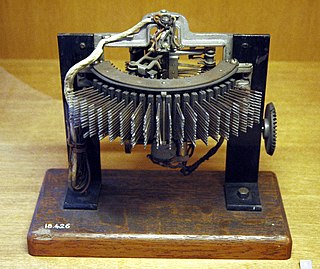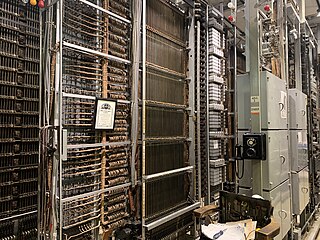
A telephone switchboard is a device used to connect circuits of telephones to establish telephone calls between users or other switchboards. The switchboard is an essential component of a manual telephone exchange, and is operated by switchboard operators who use electrical cords or switches to establish the connections.

A telephone, colloquially referred to as a phone, is a telecommunications device that permits two or more users to conduct a conversation when they are too far apart to be easily heard directly. A telephone converts sound, typically and most efficiently the human voice, into electronic signals that are transmitted via cables and other communication channels to another telephone which reproduces the sound to the receiving user. The term is derived from Ancient Greek: τῆλε, romanized: tēle, lit. 'far' and φωνή, together meaning distant voice.
In telecommunications, a called-party camp-on is a communication system service feature that enables the system to complete an access attempt in spite of issuance of a user blocking signal. This is most often found in a switchboard system at a company. Instead of going to voicemail or simply sitting on hold until the line is free, this feature places you in a queue whereby the call will be put through as soon as the line clears.
Signalling System No. 7 (SS7) is a set of telephony signaling protocols developed in the 1970s, which is used to set up and tear down telephone calls in most parts of the world-wide public switched telephone network (PSTN). The protocol also performs number translation, local number portability, prepaid billing, Short Message Service (SMS), and other services.

A blue box is an electronic device that produces tones used to generate the in-band signaling tones formerly used within the North American long-distance telephone network to send line status and called number information over voice circuits. During that period, charges associated with long-distance calling were commonplace and could be significant, depending on the time, duration and destination of the call. A blue box device allowed for circumventing these charges by enabling an illicit user, referred to as a "phreaker" to place long-distance calls, without using the network's user facilities, that would be billed to another number or dismissed entirely by the telecom company's billing system as an incomplete call. A number of similar "color boxes" were also created to control other aspects of the phone network.

The Strowger switch is the first commercially successful electromechanical stepping switch telephone exchange system. It was developed by the Strowger Automatic Telephone Exchange Company founded in 1891 by Almon Brown Strowger. Because of its operational characteristics, it is also known as a step-by-step (SXS) switch.

The North American Numbering Plan (NANP) is a telephone numbering plan for twenty-five regions in twenty countries, primarily in North America and the Caribbean. This group is historically known as World Zone 1 and has the telephone country code 1. Some North American countries, most notably Mexico, do not participate with the NANP.
A busy signal in telephony is an audible call-progress tone or audible signal to the calling party that indicates failure to complete the requested connection of that particular telephone call.
Operator assistance refers to service provided by a telephone operator to the calling party of a telephone call. This can include telephone calls made from pay phones, calls placed station-to-station, person-to-person, or collect, third-number calls, calls billed to credit cards, and certain international calls which cannot be dialed directly. The telephone operator may also be able to assist with determining what kind of technical difficulties are occurring on a phone line, to verify whether a line is busy, or left off the hook, or to break in on a live call to ask the caller to clear the line for an incoming call. The latter service is often utilized by emergency police. In addition, operators are often a first point of contact for the elderly wanting information on the current date and time.

A telephone call or telephone conversation, also known as a phone call or voice call, is a connection over a telephone network between the called party and the calling party. Telephone calls started in the late 19th century. As technology has improved, a majority of telephone calls are made over a cellular network through mobile phones or over the internet with Voice over IP. Telephone calls are typically used for real-time conversation between two or more parties, especially when the parties cannot meet in person.
Call forwarding, or call diversion, is a telephony feature of all telephone switching systems which redirects a telephone call to another destination, which may be, for example, a mobile or another telephone number where the desired called party is available. Call forwarding was invented by Ernest J. Bonanno.

A telecommunications relay service, also known as TRS, relay service, or IP-relay, or Web-based relay service, is an operator service that allows people who are deaf, hard of hearing, deafblind, or have a speech disorder to place calls to standard telephone users via a keyboard or assistive device. Originally, relay services were designed to be connected through a TDD, teletypewriter (TTY) or other assistive telephone device. Services gradually have expanded to include almost any real-time text capable technology such as a personal computer, laptop, mobile phone, PDA, and many other devices. The first TTY was invented by deaf scientist Robert Weitbrecht in 1964. The first relay service was established in 1974 by Converse Communications of Connecticut.
Last-call return, automatic recall, or camp-on, is a telecommunication feature offered by telephony service providers to subscribers to provide the subscriber with the telephone number, and sometimes the time, of the last caller. The service may also offer the facility to place a call to the calling party.

A business telephone system is a telephone system typically used in business environments, encompassing the range of technology from the key telephone system (KTS) to the private branch exchange (PBX).
An intercept message is a telephone recording informing the caller that the call cannot be completed, for any of a number of reasons ranging from local congestion, to disconnection of the destination phone, number dial errors or network trouble along the route.
1-5-7-1 is the name of a family of calling features in the United Kingdom, for residential and business telephone lines and for mobile telephones, that are provided by BT Group and several other telephone service providers. The family is named after the telephone number 1571, the special service number that is used to access it. Call Minder is the name of BT's highest level of 1571 service.
In telephony, line hunting is the method of distributing phone calls from a single telephone number to a group of several phone lines. Specifically, it refers to the process or algorithm used to select which line will receive the call.
Busy line interrupt, also known as emergency breakthrough, is a function of telephone land line carriers in which a telephone operator, by request of a caller, interrupts an existing phone conversation between other parties. This is especially useful for services without call waiting.
Toll-free telephone numbers in the North American Numbering Plan have the area code prefix 800, 833, 844, 855, 866, 877, and 888. Additionally, area codes 822, 880 through 887, and 889 are reserved for toll-free use in the future. 811 is excluded because it is a special dialing code in the group NXX for various other purposes.

The Panel Machine Switching System is a type of automatic telephone exchange for urban service that was used in the Bell System in the United States for seven decades. The first semi-mechanical types of this design were installed in 1915 in Newark, New Jersey, and the last were retired in the same city in 1983.
![]() This article incorporates public domain material from Federal Standard 1037C. General Services Administration. Archived from the original on 2022-01-22.
This article incorporates public domain material from Federal Standard 1037C. General Services Administration. Archived from the original on 2022-01-22.







